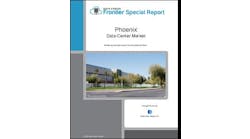New Research Reveals Persistent Array of Data Center Industry Challenges
On the heels of CBRE with its Global Data Center Trends 2023 research confirming how new technology continues to propel demand, even as persistent power constraints inhibit overall segment growth, two more recent industry reports highlight an ongoing array of business and technology challenges for data centers.
Uptime Institute discerns 'gradual' progress
Released this month, Uptime Institute's 13th annual Global Data Center Survey 2023 report finds operators facing stricter regulations and more under pressure to reduce energy consumption, along with persistent workforce and supply chain challenges.
The long-standing annual report, which delves into the digital infrastructure landscape and gives insights into its future trajectory, was based on an online survey conducted from February through April 2023 which collected responses from more than 850 data center owners and operators, plus nearly 700 vendors and consultants.
Uptime Institute says this year's research indicates that, while new technologies potentially present a promising way forward as the data center industry continues to grow in importance and scale, such technologies often are found lacking in standardization and scalability.
"While for many organizations, investments in efficiency and resiliency are beginning to pay off, progress has been gradual, with a growing proportion of workloads being outsourced," notes the report's executive summary. Remarking on this year's survey, Andy Lawrence, executive director, Uptime Intelligence, added:
“Our data shows operators grappling with several issues. In 2023, the lingering effects of the COVID-19 pandemic have receded, but other challenges have emerged. Digital infrastructure managers are now most concerned with improving energy performance and dealing with staffing shortfalls, while government regulations aimed at improving data center sustainability and visibility are beginning to require attention, investment, and action.”
PUE improvement stays stalled; cooling technology chases rack densities
Uptime Institute said that, chief among the 2023 report's findings, levels of average global power usage effectiveness (PUE) in data centers have remained flat for four years. Survey respondents’ reported average annual PUE of 1.58 this year was shown to be consistent with previous readings charting no significant reduction in PUE since 2018.
Uptime notes that since it began tracking the metric in 2007, "industry-average annualized PUE fell sharply from 2.5 to 1.98 in 2011 and then to 1.65 in 2014; since then, it has hovered close to this level." The report states that additional improvement will require significant investment by operators. The executive summary further advises:
"This does not indicate an end to technical innovation in data centers. Rather, it reflects the tapering off of relatively easy gains in energy performance from better air-flow management, optimized environmental controls and some upgrades to electrical systems in legacy facilities. Further efficiency gains in many existing facilities would require major refurbishments that are both costly and potentially disruptive to a live environment -- if such a retrofit is feasible at all."
If PUE has flatlined, this year's survey shows data center server rack densities climbing steadily but slowly, with most operators not reporting any racks beyond 20 kW, and average rack densities below 6 kW per rack. The report's summary suggests that these data points suggest "the widespread use of direct liquid cooling is not imminent."
However, while few operators have racks over 30kW, the survey finds more extreme densities definitely emerging; and this year, operators were also asked how they cool their highest density cabinets. Because many facilities have no IT installations that would pose a thermal challenge, Uptime Institute noted that perimeter cooling -- including computer room air conditioners, computer room air handlers or fan wall systems -- was top-ranked by far, with 56% reporting its usage.
Even on the densest racks, the survey found perimeter cooling technologies dominating, with only one in five operators (18%) reporting use of close-coupled air cooling for their most powerful racks, and one in nine respondents saying they used some form of DLC, such as cold plates or immersion. For racks above 40 kW, air and liquid cooling were shown to be evenly split as the thermal management method of choice.
Uptime said it anticipates the numbers will shift in favor of close-coupled air and DLC systems in the future, "pushed largely by the continued escalation of silicon power density and a tighter integration of IT components ... The potential for gains in energy performance and water consumption will further bolster the business case for DLC," added the report's summary.
Outages still expensive; workforce staffing still needs work
In this year's survey, power issues continued to be cited as the single biggest cause of data center outages, though trending toward steady improvement. Uptime Institute's data said that more than half of operators (55%) reported having had an outage at their site in the past three years, the lowest number yet recorded.
However, the survey notes that while operators do appear to have reduced the likelihood of the most serious and severe outages, the cost of outages remains high, with about half of the respondents (54%) saying their most recent significant, serious or severe outage cost them more than $100,000, with roughly one in six (16%) saying that their most recent material outage cost them more than $1 million.
Meanwhile, the survey's staffing data indicates that only approximately 8% of the data center workforce is comprised of women; Uptime notes that in the US, relative to a 2021 publication by the US Bureau of Labor Statistics (Employment and Wages Online Annual Averages), this rate is below that of other male-dominated industries, such as mining and construction.
Uptime Intelligence notes it has been tracking gender dynamics since 2018, and reports that the very low proportion of women in design, build and operations teams has not meaningfully increased over time. Globally, nearly two-thirds of operators polled this year said they have problems recruiting or retaining staff with largest skill gaps occuring in operations, mechanical and electrical roles.
The report's executive summary added, "A large majority (81%) of data center teams are overwhelmingly male, with one in 10 women or fewer. Almost one in four (24%) respondents say they have no women at all in these job roles." Uptime Institute advised that operators seeking to attract and retain qualified staff should consider active DEI efforts to avoid overlooking women and other underrepresented candidates.
Sustainability, AI and hybrid IT prospects
This year's Uptime Institute Global Data Center Survey found that many operators only collect a limited amount of sustainability related data "and will struggle to meet emerging sustainability reporting requirements, or in turn, the requirements of some customers and the public," as reckoned by the report's executive summary.
Meanwhile, while most operators polled said they believe acceptance of the use of artificial intelligence will grow in data centers, the survey found companies distrustful of the technology's ability to make reliable operational decisions.
Elsewhere in the survey, enterprise operators cited data security as the biggest impediment to moving mission-critical workloads to the public cloud, with resiliency and transparency coming in as lesser concerns.
Notwithstanding, as more organizations opt for a hybrid approach to IT, the share of enterprise workloads that are run in corporate, on-premises facilities was shown to have fallen to below half for the first time, and is expected to shrink further in coming years, according to Uptime Institute.
On-premise data center capacity - larger than appears in rearview?
Echoing certain findings in Uptime Instite's survey, new research from Synergy Research Group discerns increasing encroachment by hyperscalers and colocation companies on capacity held by on-premise data centers.
The firm's hyperscale research gathers up data center footprint and global operations of 19 major cloud and internet service firms, including the largest operators in the segments for XaaS (including SaaS, IaaS, PaaS), search, social networking, e-commerce and gaming. Colocation and leased data center figures are based on the firm's in-depth tracking of the colocation space, assessing quarterly market data from more than 230 individual companies.
The research finds present-day spending on data center hardware and software has only grown by an average 2% per year, while spending on cloud services exploded by an average of 42% per year to reach $227 billion in 2022.
Contrast those averages to a decade ago, when enterprise spending on then-emerging cloud infrastructure services came in at well below $10B, with the same companies shelling out over $80B per year on IT hardware and software for their in-house data centers, as reckoned by Synergy Research.
"Furthermore, while enterprises did maintain or slowly grow spending on data center equipment, a growing proportion of that gear has been pushed offsite into colocation facilities," added a statement from the analyst, which concluded that "on-premise data centers will not disappear any time soon, but their scale is being increasingly dwarfed by hyperscale and colocation companies."
A stark contrast
Synergy finds approximately half of hyperscalers' capacity operating in own-built, owned data centers, and half operating in leased facilities. The firm's latest analysis contends that hyperscale providers now account for 37% of the worldwide capacity of all data centers, spanning close to 900 large-scale facilities.
Non-hyperscale colocation facilities are seen accounting for another 23% of capacity, with on-premise data centers presently rounding out 40% of the total.
The contrast to five years ago is stark, when almost 60% of data center capacity was found in on-premise facilities. Looking ahead five years, hyperscale operators are expected to account for over half of all capacity, with on-premise data centers dipping to under 30%.
The good news is that the total capacity of all data centers should continue to rise steadily, but Synergy notes that increase will be driven primarily by hyperscale capacity almost doubling over the next five years.
Synergy Research says colocation share of total capacity should remain relatively constant, admitting that while on-premise share of the total might drop by over two percentage points per year, the actual capacity of on-premise data centers will decrease only marginally.

Matt Vincent
A B2B technology journalist and editor with more than two decades of experience, Matt Vincent is Editor in Chief of Data Center Frontier.





